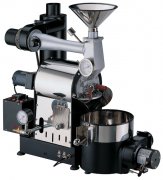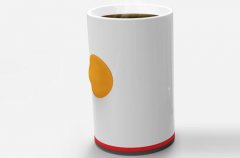Non-electric coffee bean roaster made by Japanese engineers

Yasuyuki Fujimura created a "no-electricity studio" in Naxucho, Japan.
In 1953, the world's first washing machine was introduced in Japan; in the same year, the national color TV standard was set. Since then, household appliances began to enter thousands of households, so 1953 is also known as the "first year of electrification". The opening of the electrification era marks the peak of human demand for energy, and now human dependence on electric energy has reached an indispensable stage.
Although the trend is still spreading, Yasuyuki Fujimura, an engineer and inventor in Japan, strongly advocates living without electricity. He advocates avoiding the use of electricity in daily life as much as possible, but his advocacy is not "anti-electrification", but to enjoy a moderately comfortable and convenient life without relying on electricity.
Fujimura has a doctorate in physics and used to work in a large equipment manufacturer in Japan. He is an elite in the industry and has been involved in the development of many advanced technologies, such as plasma equipment, waste heat power generation systems and gas-fired heat pumps. Yasuyuki Fujimura is a big fan of electrification, but all that changed with the birth of his son. Fujimura's son was diagnosed with allergic asthma at birth, and he found that at that time, in the 1980s, the number of children with the disease was growing at an amazing rate. With further research, Fujimura found that the main culprit of this phenomenon is the deteriorating natural environment. He believes that the rapid economic growth and the rapid development of science and technology, coupled with people's pursuit of a more and more comfortable and convenient way of life, have finally led to the deterioration of the living environment.
In order to create a new way of life, Fujimura began to create the theme of "Life without electricity" in 2000 and set up its own "No electricity Studio" in 2003. He hopes to develop a lot of household devices that do not need to use electricity.
Yasuyuki Fujimura's "No electricity Studio" is located in Natsucho, Japan, covering an area of about 1 hectare. The whole studio completely presents the theme of "living without electricity". The outer wall of the studio is filled with grain husks, and its thermal insulation performance is comparable to that of glass wool. Indoor composting toilets use microbial fermentation to convert human waste into fertilizer, the whole process does not need to use an electric pump. In addition, the studio bathroom also uses a variety of energy sources, such as solar energy, firewood and even garbage.
In Fujimura's studio, similar facilities without electricity, such as refrigerators, can be found everywhere. The refrigerator adopts the working principle of radiation cooling and natural convection of water flow. The cooling device of the refrigerator is made of high thermal conductivity metal, which is surrounded by about 250 liters of water as coolant, and the cooling panel is placed on top of the refrigerator. In the course of work, the heat of the food stored in the refrigerator is transferred to the water through the high thermal conductivity metal, and as the temperature increases, the heat rises to the top cooling panel, which is then transferred out through the principle of radiant cooling. The cooling system is most efficient at night when it is dry, because there is the least amount of water vapor in the air. Even in a hot summer, it only takes a dry night to keep the temperature in the refrigerator at 7 to 8 degrees Celsius for three days.
Another popular non-electric household device in Fujimura Yasuji's "No electricity Studio" is the coffee bean roaster. The roaster is made of aluminum and looks like a pan. When using it, just put it on the gas stove, then put in the raw coffee beans, then hold the handle of the roaster and shake it left and right for five minutes to stir-fry the coffee beans. From adding raw coffee beans, cooling, grinding to brewing fresh coffee, the whole process takes only 25 minutes. Mr. Fujimura said the coffee bean roaster was so popular that he had sold 8500 of them so far without advertising. "I think most people buy this product because they like to enjoy the whole process of making coffee," he said. Nowadays in Japan, people are pursuing a more comfortable, convenient and fast way of life, but this way of life is not always pleasant. The popularity of this roaster shows that some people are beginning to realize that speed is sometimes not the best choice. "
Although the coffee bean roaster is a very simple tool, it took Fujimura six months to develop it. In order to ensure that the coffee beans are heated evenly, the roaster needs to be made of metal with very good thermal conductivity; in addition, its shape design must also take into account that the raw coffee beans can easily roll freely in the container; even the sound of coffee beans rolling is required to sound pleasant.
Fujimura said that the "electricity-free lifestyle" he advocated does not mean that there is no need for electricity in life, but a philosophy of life, that is, using appropriate technology to live a happy and colorful life without relying on energy and money. Fujimura's dream is to build his "no-electricity studio" into a theme park, showing people options other than household appliances, hoping that they can find the fun and variety of life. He wants to show people that with little or no energy consumption, the "electricity-free lifestyle" is attractive, healthy and beneficial, and more importantly, the cost of this lifestyle is low. Mr Fujimura hopes the idea will attract attention among the younger generation, many of whom cannot afford high house prices.
After the March 11 earthquake in Japan, people all over the world, including Japan, have begun to realize that the energy crisis is getting worse. In this context, Fujimura's concept is particularly important. (Jin Ming)
Important Notice :
前街咖啡 FrontStreet Coffee has moved to new addredd:
FrontStreet Coffee Address: 315,Donghua East Road,GuangZhou
Tel:020 38364473
- Prev

Taiwan Yangjia 800N fever grade small roaster
Taiwan Yangjia 800N fever grade small roaster
- Next

A self-heated coffee cup
Burning Cup is a cup designed by designer Ryan Jongwoo Choi, which embeds sodium acetate into the coffee cup and uses the principle that sodium acetate will form liquid when it is hot and become solid when it is not as expected. As long as you press the yellow button, sodium acetate will produce the effect of heating, and the cold coffee will heat itself, which is very convenient. | |
Related
- What is the Philharmonic pressure? How to use Philharmonic pressure to make delicious coffee
- Why does a hand grinder have more fine powder than an electric grinder?
- In addition to the hot mom, what is the difference between the versions of EK43 | ditting and Mahdi ek43?
- What kind of equipment do you need to make coffee by hand? Introduction to novice starter cooking equipment tools
- Espresso needs to be ground how thick and thin scale entry Italian Coffee Machine Bean Grinder investigation and Grinding course
- How much does it cost to open a small private cafe? How much does it cost to learn coffee? How to operate it?
- The difference between the flavor characteristics of hand-brewed coffee and coffee maker is hand-brewed coffee really better than coffee maker? Can I use a coffee machine to make coffee beans by hand?
- The difference between 01 and 02 of hario v60 filter cup what is the difference between 01 and 02 filter cup opening and cooking flavor
- What's the difference between the smart cup and the French kettle? Which is better, the French kettle or the Smart Cup?
- What's the difference between a smart cup and a V60 filter cup? The difference between the taste of smart cup and hand-brewed coffee

